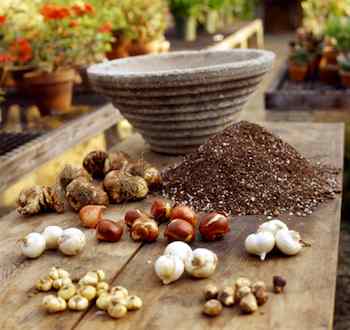By Sean Conway

Bulbs of different flowers can be planted in the same container. Layer them in potting soil mixed with grit, sand or gravel. Arrange larger bulbs in the lowest layer and smaller ones on top or around the edges of the pot
When it comes to ordering seeds and bulbs from glossy garden catalogs and websites, I tend to get carried away. I inevitably order more than I need and more than I usually have time to plant. Fortunately, when stored properly, unused seed can be planted at a later date. Bulbs, however, don't store well and will be useless if not planted within a short time.
Rather than throwing leftover bulbs away, I pot them up in mixed bulb containers. That is, I plant several types of flowering bulbs in one pot. One of the best methods for doing that is to layer the bulbs, with larger ones on the bottom and smaller ones near the top of the pot. Leftover bulbs can be forced for indoor use, but rather than giving up windowsill or countertop space -- which is already at a premium in our house -- I pot them in large cement pots for outdoor use.
Potted bulbs need a cooling-down period, just as they do when planted in the ground, in order to form roots. For most bulbs, this period lasts between eight and 15 weeks. During this time they need temperatures that are between 50 degrees and freezing. This can be accomplished either by storing the pot in an unheated garage or shed, or (for folks living in warmer climates) by storing the pots in an old refrigerator.
I plant mine and leave them in an unheated greenhouse. Some people bury the pots in the ground outside. If you choose this method, make sure the top of the pot is level with the surrounding soil. This method alleviates watering duties, but the pots will need to be dug up and cleaned off come spring. Remember to use plastic, fiberglass or cement pots when burying them in the ground, as clay pots will crack if allowed to freeze.
Here are the steps I use to pot up mixed bulb pots.
1. Choose a large frost-proof pot; I prefer cement or fiberglass pots because of their durability. Mix one part grit, sand or gravel to three parts all-purpose potting soil. Adding sand or gravel ensures the bulbs have good drainage, which is a must.
2. Add some soil to the bottom third of the container and begin planting the bulbs with their flat sides down. As a general rule, start planting larger sized bulbs such as daffodils or tulips first. Cover the bulbs with soil and begin the next layer. Small bulbs are best placed on the top layer or around the outside rim so their larger neighbors will not obscure them. Larger bulbs require on average 6 to 8 inches of soil over them, and smaller sized bulbs such as crocus and muscari need only 3 to 4 inches.
3. Next add a 1-inch layer of fine gravel over the surface of the soil and water the pot well. Adding gravel on top prevents the soils from washing away when watering the pot.
4. Store the container in a cool, dark place where temperatures remain above freezing but below 50 degrees. The bulbs should remain in this cool location for at least two-and-a-half to three-and-a-half months, or until bulbs begin showing signs of growth in your garden.
5. Once the bulbs begin to grow (i.e., when growth is visible poking through the soil) you can move the container outside and the bulbs will continue to emerge and bloom as they would if planted in the ground.
Be sure to check periodically to make sure the soil does not dry out. Bulbs prefer moist but well drained soil.
One of the advantages to planting bulbs in mixed containers is that you can place them wherever you want spring color. Another is that ordering too many bulbs from glossy catalogs or websites is no longer a problem!
Available at Amazon.com:
Trowel and Error: Over 700 Tips, Remedies and Shortcuts for the Gardener
Cut Your Energy Bills Now: 150 Smart Ways to Save Money & Make Your Home More Comfortable & Green
It's Easy Being Green: A Handbook for Earth-Friendly Living
Copyright © Cultivating Life by Sean Conway. All rights reserved.
AUTOS | HOBBIES | EDUCATION | FAMILY | FASHION | FOOD & RECIPES | HOME DECOR | RELATIONSHIPS | PARENTING | PETS | TRAVEL | WOMEN
Home & Garden - Order Too Many Bulbs? No Problem: Just Pot Them